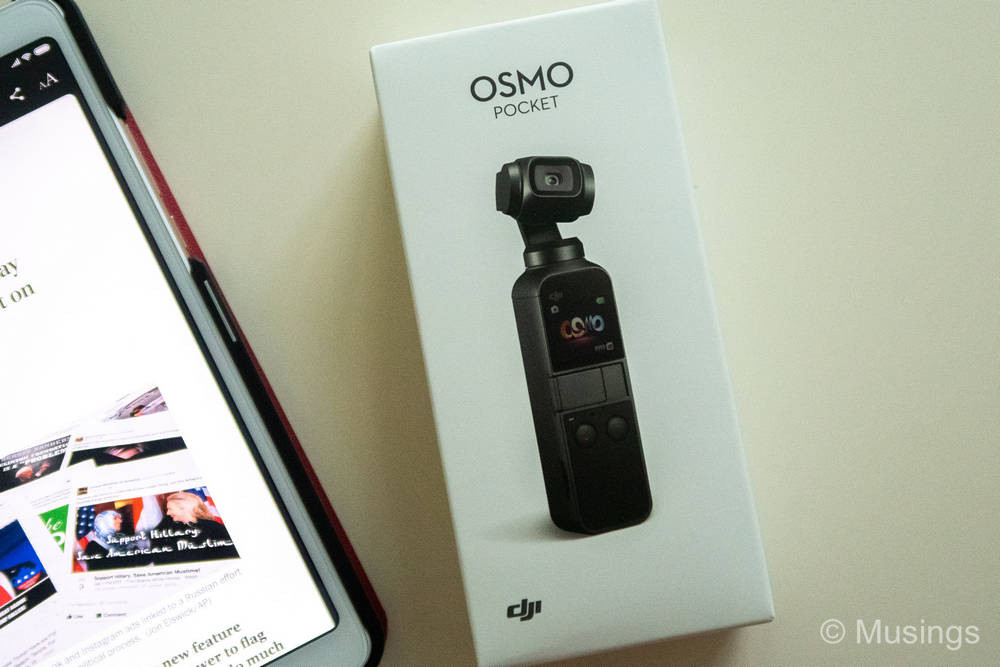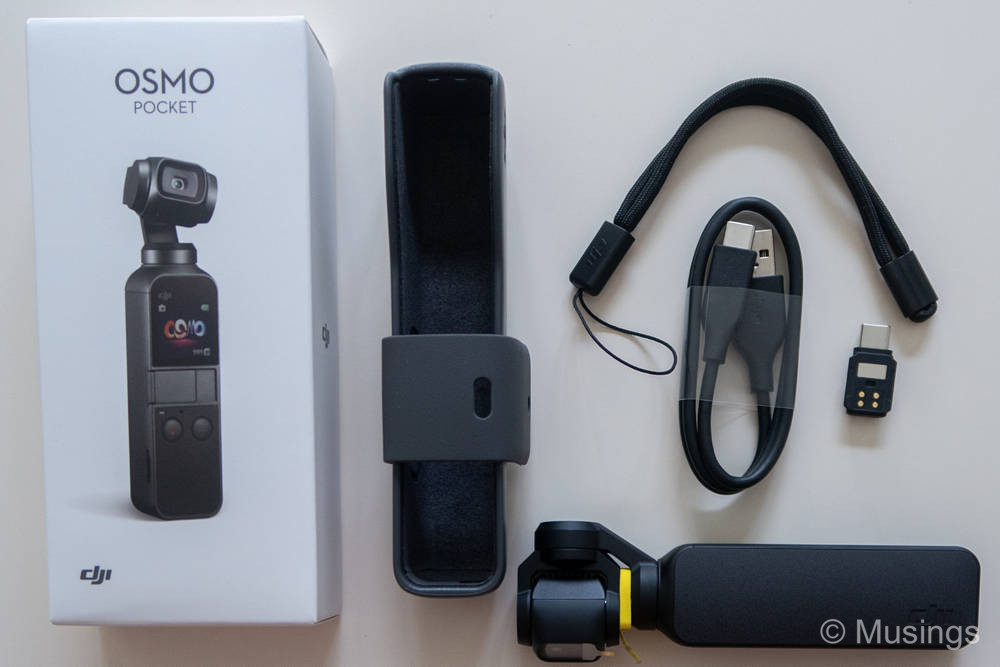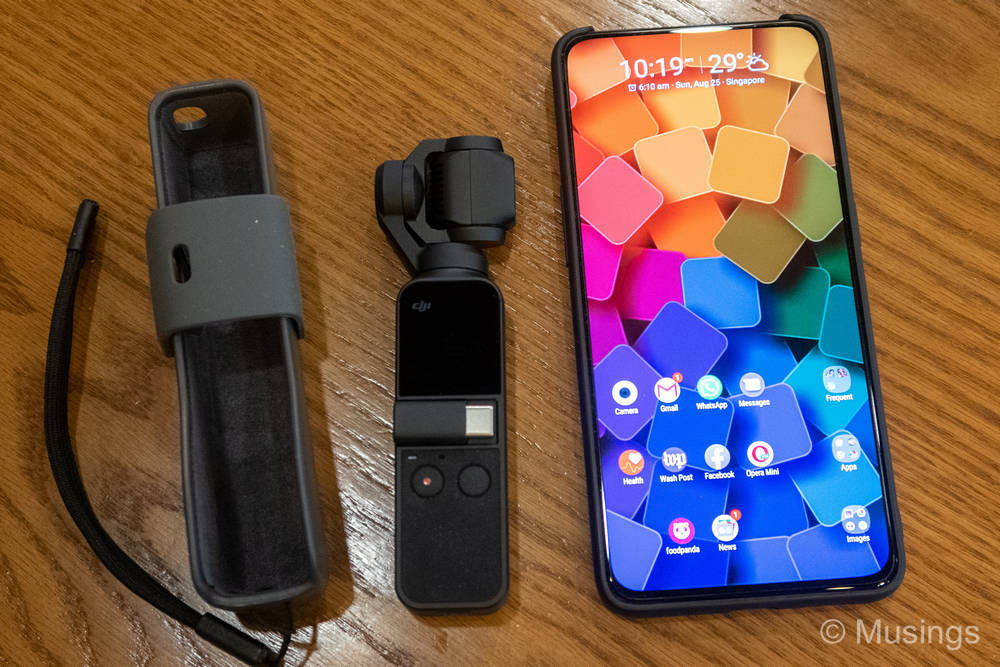I haven’t been putting much attention on smartphone gimbals, despite having one in the drawer – a Zhiyun Smooth-Q 3 axis controller – for several years now. These three axis gimbals offer a degree of stabilisation that smartphones and the tight confines their mechanisms need to work within simply cannot muster. Unfortunately, the smartphone gimbals are also relatively large, and require deliberate and planned use: it’s simply not something I can throw into my sling bag during travel, fish it out and have it ready to use in two seconds.
Enter the DJI Osmo Pocket – a tiny gimbal controller with a big twist: rather than rely on the smartphone for image and video capture, the Pocket shoots with its own dedicated sensor and lens – a smartphone is not actually necessary any more, though still useful if you’d like to tweak the camera’s settings and do fine control during capture. The device isn’t actually a just-released product: a friend in The Minton residents Facebook group received one as a present for her vacation last year. At that point, I wasn’t familiar with the product, and upon learning its listed price – around SGD550, compared to around SGD150 for an entry-level smartphone gimbal – I was actually dismissive of the Pocket as I didn’t know its actual capabilities. I only revisited the product a few months ago after not being particularly impressed with the Oppo Reno 10x Zoom’s 4K video stabilisation, and started reading up more about the little device, and also where bargains can be had for it.
So, one purchase later – my comments on the device after more than a fortnight of use!
The asking price for the device here in Singapore seems to span quite a range. As a baseline, Amazon US lists the Pocket at USD378/SGD524, while locally, the recommended retail price in the large stores seems to be around SGD519. The prices for online retailers here are all over the place, with some charging in excess of SGD600 for it, with about SGD469 being the lowest street-price offered from small retailers. I eventually picked one up for SGD465 – nominal difference of just a few dollars, but still. Since my purchase almost three weeks ago though, the street price at the brick and mortar camera enthusiast stores have dropped even lower. I’ve seen the gadget sold for as low as SGD420 now. That’s an amazing bargain.
My first impression of the Pocket: wow – this thing is tiny. And light! The Pocket feels very well made, solid, and its external feels metallic. The back of it – where the LCD is and facing you – is also partially covered with a felt like material that aids a little in grip.
I’ve been shooting primarily in 4K 60fps, and the unit can get warm when shooting for more than a few minutes in 4K. Nothing uncomfortable, but it’s noticeable enough. 4K video footage out of camera is very good – at least when in good light: it’s sharp, contrast-y, and thanks to that gimbal, well-stabilised with none of the jitter common in 4K videos taken using smartphones, including even the Samsung Note 9. However, video shot in low light sees visible noise and grain. Moreover, the Pocket at the moment supports only H.264 codecs – which is a letdown, with 4K 60fps video footage at about 100Mbps bit rates. The hardware should be able to support the more efficient H.265 codec, so hopefully DJI will include this in a firmware update soon. I also haven’t done a head to head comparison against my GoPro 7 Black yet. But according to some YouTube comparisons I’ve seen, the Pocket at least matches and possibly surpasses the GoPro even.
Controls on the Pocket is done through the two physical buttons, and a small LCD screen. The controls and UI can be a little overwhelming at the start, but I got the hang of it after just a few days. Your current settings are saved when you power-off the Pocket, and restored when you power it on again. Horizontal and vertical panning can also be done through the smartphone app, and there’s also a virtual controller if you’d like full-control of the camera head. Panning is a lot easier altogether though using the optional Controller Wheel accessory that I also picked up. The wheel itself on this add-on doesn’t offer much resistance, so the wheel needs to be turned gently.
Subject tracking does not work too in 4K 60fps. That’s a feature omission I was well-informed of prior to purchase and I’d initially thought that’d would significantly limit the way I use the camera. As it turned out, Tracking itself isn’t 100% reliable, and the subject track itself gets lost when there are are a lot of background objects also moving. I ended up not using subject tracking when in 4K 60fps altogether.
The unit comes with its own premium case – super useful. Unfortunately, the design of the case has some oddities. Specifically, the supplied hand loop attaches itself to the case, but I haven’t found a way to attach the same to the Pocket Osmo itself. In other words, the loop secures the case to your wrist – but does absolutely nothing when the camera comes out for use.
Panoramas are super easy to create, and there are two options for it: a left to right 180 degree sweep where the Pocket will take four images, and a 3×3 image composition where the camera head will swivel in a Z sweep. Like every camera out there, panoramas will always look best when objects are static, e.g. scenery. Still, it’s pretty cool watching the lens swivel from spot to spot to take an image. Stitching images in camera is a completely different thing – it doesn’t seem possible. I have to go to DJI’s Mimo app – whereupon it’ll export the stitched panorama as a severely downsized sample. Specifically, the 180 degree and 3×3 panoramas result in images there are approximately 4,100×1028 and 2,400×1700 pixels in size. You’d get much higher resolution pictures if you don’t use the Mimo app but instead take the original images off camera and stitch them using any one of your favourite image processing programmes.
The USB-C connector is quite fiddly. It’s tightly fits the Pocket yes, but when hooked up to a smartphone, the latter’s weight and size relative to the diminutive Pocket makes the entire contraption feel off balance and precarious to hold! You desperately need a smartphone + Pocket holder if you see yourself using this combo for any substantial period of time.



In all, the Pocket Osmo is a terrific device, and since it’s acquisition, I’ve stopped taking videos on my Oppo Reno altogether. Yes, it’s an additional gadget to bring along when I’m out of the house, but the quality of stabilized video footage is just that much superior. The cheapest I’ve seen for the gadget now is SGD420. That might be a seasonal discount yes, but if you’re on the lookout for a reasonably capable and very portable tool to take videos, this could be it.
The Pocket will be coming along for my Japan trip this coming weekend, so it’ll likely see extensive use and I’ll update the post then with onsite videos taken using it. More to come soon!
Recent comments